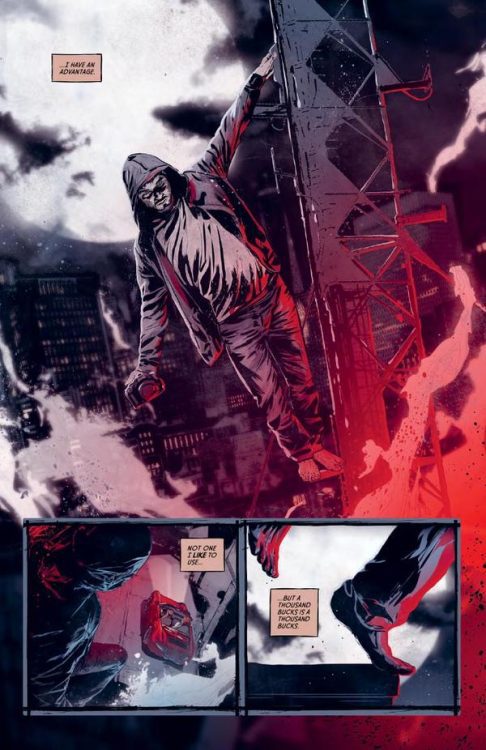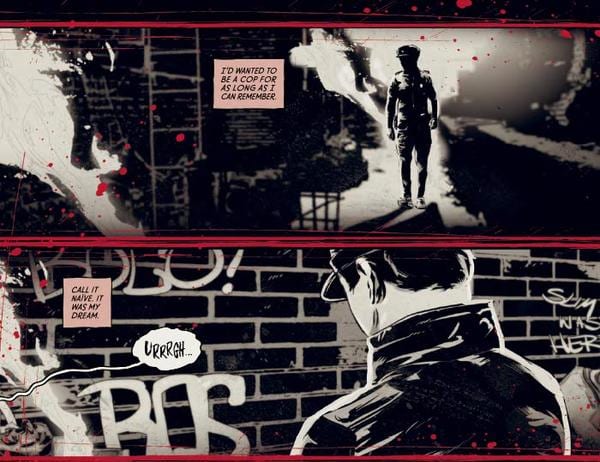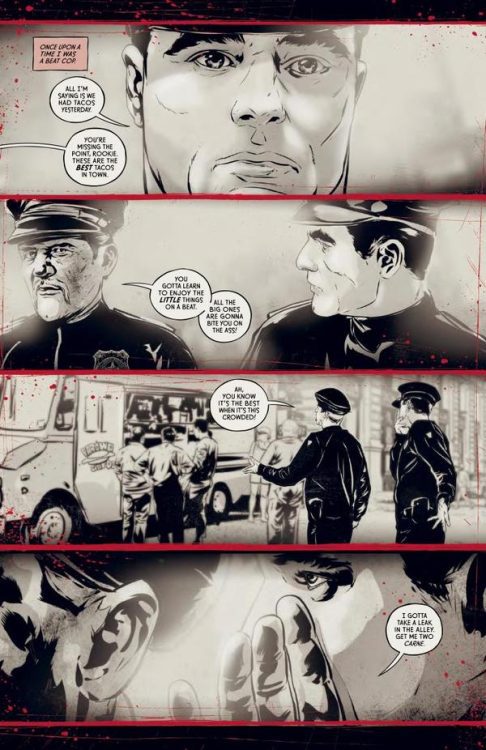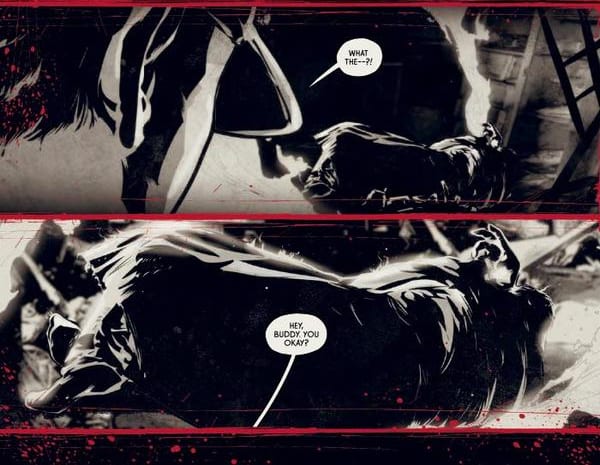Merging genres is commonplace in Comics, and some groupings are better suited than others. This is abundantly clear in TKO Studios’ Lonesome Days Savage Nights written by master of horror Steve Niles and, co-founder of TKO Studios, Salvatore Simeone. The new hard-boiled horror comic crawls through the filthy streets, meting out its own form of justice in a thinly veiled metaphor for Intermittent Explosive Disorder.
Part An American Werewolf in London, part The Crow, Lonesome Days Savage Nights is a dark exploration of a man’s soul as he tries to come to terms with the pain in his life. This is achieved through the use of a classic monster of rage, the werewolf, and the setting of the story. Niles and Simeone take aspects of Noir fiction, elements of horror, and mix them with a healthy portion of comic tropes.
“This damned burg’s getting me. If I don’t get away soon I’ll be going blood-simple” Dashiell Hammett – Red Harvest
MFR ON YOUTUBE (latest video)
Help us reach 5K Subs!

Dual Character
The premise for Lonesome Days Savage Nights is a simple one, in the same way any private eye, pulp fiction narrative is simple. There is always a straightforward crime to be solved that leads the protagonist down a labyrinth of unfortunate events and to a party of unscrupulous people. The twist with Niles/Simeone’s concept is that their central character also happens to be a werewolf. Stu is an ex-police officer who has set himself up as a private detective in a style familiar to readers of Marvel’s Alias. The jobs aren’t pretty or pleasant but they pay the bills and distract Stu from himself.
The werewolf angle is introduced in a way reminiscent of the Angel television series, as if the beast is an advantage to the investigative nature of Stu’s life but quickly it becomes apparent that it is a constant battle. The bouts of anger and constant suppressive drinking marks Stu out to be a man desperate for help. In the story his anchor is Audrey. She has a calming effect on Stu, allowing him to control the beast inside and focus the rage into his work only when he needs to. But this is a tragedy; a story packed with unfortunate events and it is clear almost from the beginning that in the war to control his inner self, Stu isn’t going to be the victor.
Stu’s tale of horror, from his attack by a werewolf as a police officer to the tragic events in the opening chapter of the comic, is a litany of classic horror motifs submerged in a noir style. The writers give Stu a pessimistic voice so that the reader is constantly aware of the characters woes and depression. Stu’s inability to accept himself and his situation is paramount to the story. He drinks to escape but is also aware that it weakens his control over the animal inside. He is in constant battle with himself and Niles/Simeone layer the narrative with this conflict.

The Darkness in the Gutter
The fight doesn’t remain in the narrative, but instead drains out into the artwork. Szymon Kudranski’s style is very visceral with emotional character renderings and heightened expressions. The line work is extremely detailed but also cast in oceans of shadow, forcing the reader to peer closer and closer to the page to glean as much information as possible. This, by its very nature, brings the reader into the comic, both physically and emotionally. Kudranski traps you with his artwork and brings you down to the same level as the protagonists.
It becomes impossible to escape from the sounds and smells of the streets and filthy apartment blocks. The colors in the printed version are murkier than the smoother, cleaner version you can sample online. This adds an extra level of texture to the images and the readers experience. You can’t help but get your hands dirty by holding the book, with your fingers unavoidably slipping into the images as they bleed to the edge of the page. Even the lettering by Thomas Mauer has a grittiness to it with Stu’s internal monologue encased in liver pink colored caption boxes, and the whites of the speech balloons somehow lose their intensity, as if they are being invaded by the shadows in the panels.
There are two outstanding visual elements to Lonesome Days Savage Nights. The first is the sound effects which are torn from the page. Their integration into the artwork is seamless and yet they tear themselves away from the action to resonate with the reader. You may not hear these guttural snarls and blood curdling screams but you definitely feel them.
The second aspect is the form of the panels themselves and the treatment of the borders/gutters. Throughout Kudranski rips into and splatters the gutter, breaking the frames of the panels and bleeding the images into each other. This constantly shifting border style is representative of Stu’s inconsistent state of both body and mind. The violence of his change from man to wolf and the frustration he feels at his life is reflected through the comics form, often more successfully than some of the textual narrative.

Conclusion
Lonesome Days Savage Nights is, on the surface, a classic monster movie and can be enjoyed simply for it’s violent revenge story. However, dig a little deeper and you get a story of mental instability. The central character is dealing with a violent rage he can barely control. There are moments of stability and moments of fracture and anger where he strikes out. The physical trauma Stu experienced as a police officer has left him psychologically scarred and his coping mechanisms, or lack thereof, are the main thrust of this narrative.
There are problems with this book, mainly to do with overused tropes. The first chapters plot is formulaic and doesn’t offer many surprises after the beautiful transition spread on the second and third pages. The influences from other media are sometimes too obvious, causing friction to the reading experience. For example, one of the characters is a merging of Jack Goodman from An American Werewolf in London and the guiding Crow from J O’Barr’s The Crow. The merging is obvious and acknowledging this for a moment pulls you away from the story.

Once you have escaped from the cliches of the plot early in the comic, Lonesome Days Savage Nights is an engrossing tale of internal violence and repressive anger. The over familiar elements slink into the background as the fast paced narrative drags you through grimy streets and broken lives. Kudranski’s artwork, complemented by Mauer’s lettering, is engaging and emotive throughout. The design of the layouts and the attention given to the comics form is as impressive as the images themselves.
TKO Studios have some exciting creators on their roster, and Lonesome Days Savage Nights is a prime example of the brilliance that they can achieve.
Available in either Graphic Novel format or a collection of six, individual issues, Lonesome Days Savage Nights is waiting to draw you in and rip you apart.

